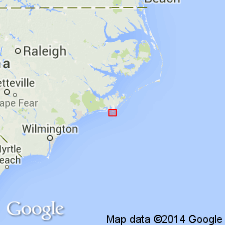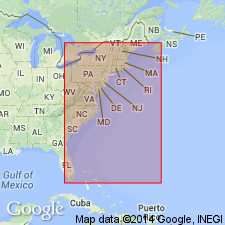
- Usage in publication:
-
- Diamond City Clay
- Modifications:
-
- Named
- Dominant lithology:
-
- Clay
- AAPG geologic province:
-
- Atlantic Coast basin
Summary:
Diamond City Clay, here named in Carteret Co., NC, described as gray soft silty illite-rich clay interbedded with shell hash in sandy clay matrix. Thickness is 6 m at type. Disconformably overlies informal Core Creek sand (Pleistocene); unconformably underlies informal Outer Banks sand (Holocene). Pleistocene age (29,280-12,280 yrs old) from shells, wood, and peat.
Source: GNU records (USGS DDS-6; Reston GNULEX).

- Usage in publication:
-
- Diamond City Formation
- Modifications:
-
- Revised
- AAPG geologic province:
-
- Atlantic Coast basin
Summary:
Diamond City here referred to as Formation rather than Clay. Data of Belknap and others (1984: GSA Abs, v. 16, p. 2-3) indicate unit contains shells of several ages, from early to latest Pleistocene.
Source: GNU records (USGS DDS-6; Reston GNULEX).
For more information, please contact Nancy Stamm, Geologic Names Committee Secretary.
Asterisk (*) indicates published by U.S. Geological Survey authors.
"No current usage" (†) implies that a name has been abandoned or has fallen into disuse. Former usage and, if known, replacement name given in parentheses ( ).
Slash (/) indicates name conflicts with nomenclatural guidelines (CSN, 1933; ACSN, 1961, 1970; NACSN, 1983, 2005, 2021). May be explained within brackets ([ ]).

